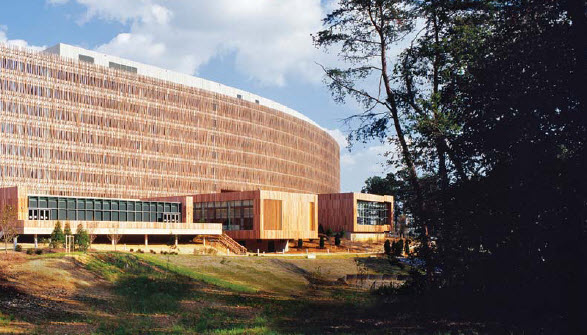The 1.5 million square foot U.S. Census Bureau Headquarters, Suitland, MD, was designed to be the architectural expression of “sustainability” and a showcase of sustainable building design for the General Services Administration and the Federal government.
Set in an 80-acre woodland preserve, the two buildings comprising the Headquarters have been conceptually “cleaved” from a single mass and constructed around a central garden courtyard and other sustainably landscaped gardens.
|
|
Woodland-facing facades are clad in a unique, sustainable-oak architectural sunshade that mimics forest shapes and allows the buildings to blend into the wooded setting. Courtyard-facing facades are clad in glass embedded with a shading frit (a shading frit is made by adding ground glass particles to glass, creating integral shading), mimicking the curved shapes of the wooden sunshade. Parking structure green screens feature three seasonal varieties of climbing ivy, which act as a highly permeable “skin” of light-filtering leaves, increase oxygen levels in the garage, and allow for natural ventilation.
Scenic views are brought into the workplace year-round as the natural foliage of the woodland and landscaped gardens changes.
The interior concept features a “Mainstreet” concourse (a main underground concourse) illuminated by colors of the spectrum, which animates the spaces and assists wayfinding (navigating the space). Employee amenities along “Mainstreet” include an auditorium, library, conference center, credit union, and a cafeteria. In woodland-abutting spaces, where the outdoors provides orientation, interior color scheme is subdued natural hues.
The project was designed to LEED© (Leadership in Energy and Environmental Design) Silver standards. According to the final Energy Analysis Report by the designer/builder, the project saves an estimated 15.8 percent in energy use as compared to traditionally designed buildings. Sustainable features include:
- water efficient landscaping;
- water retention ponds 100 percent available for onsite landscape irrigation;
- waterless urinals and low-flow faucets that reduce water use by 36.2 percent;
- green roofs (doubling as vertical pedestrian parks) that cover 50 percent of total roof area;
- regional materials (50 percent from within 500 miles);
- 75 percent (or more) recycling or salvage of construction waste;
- 10 percent recycled content in building materials;
- low-VOC (volatile organic compounds) paints and non-urea formaldehyde products;
- maximized natural daylight;
- self-dimming illumination and energy-saving lighting motion sensors;
- innovative exterior sunshade of FSC-certified wood (FSC – Forest Stewardship Council);
- garages’ green screens that improve air quality;
- minimal land disturbance (buildings occupy only 50 percent of the site); and
- direct access to Metrorail (subway), and parking limited to 3,000 cars, 310 bike racks, and travel-reducing onsite employee amenities.
|
|
| Photo: Edward Hueber/archphoto.com |
In short, there is no other building complex like this in the world. The complex stands as a model for future offices of the Federal government and has already become a cherished part of its setting.
Contact:
Jag Bhargava
Project Executive
Project Development Division
Public Buildings Service
National Capital Region
U.S. General Services Administration
jag.bhargava@gsa.gov







